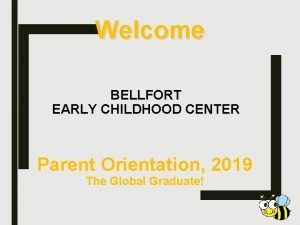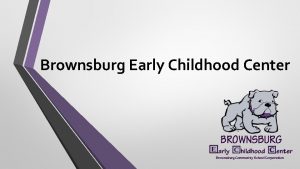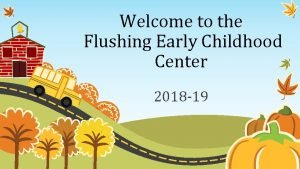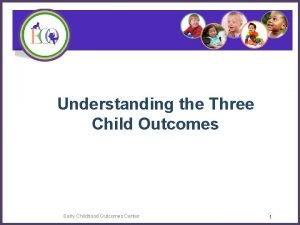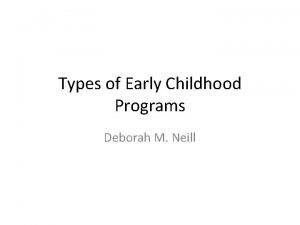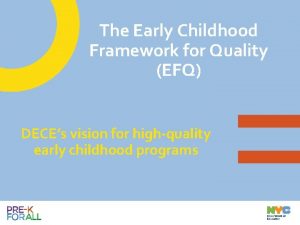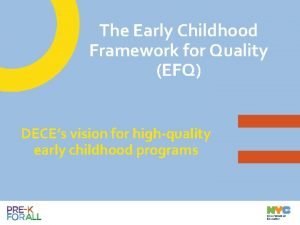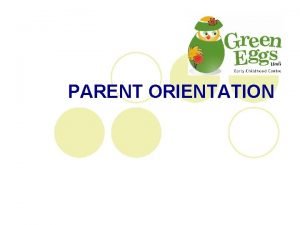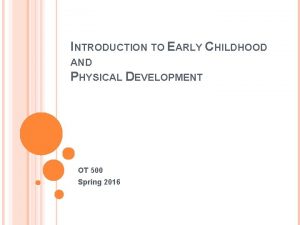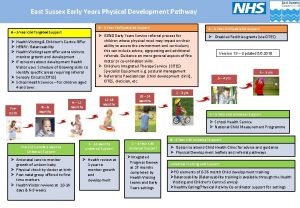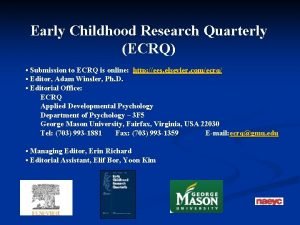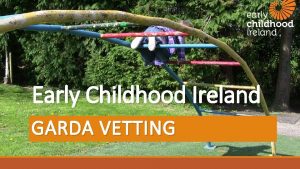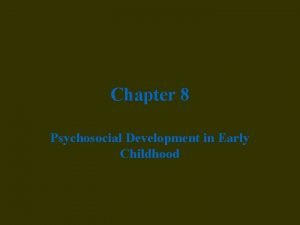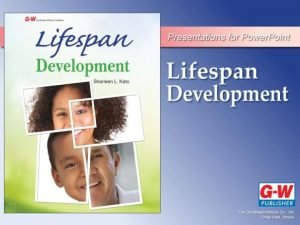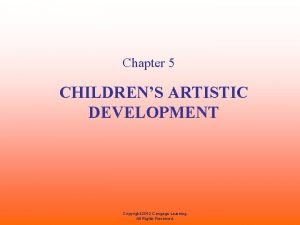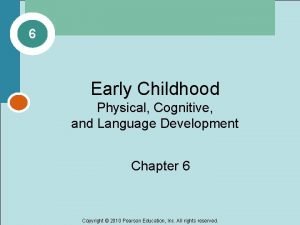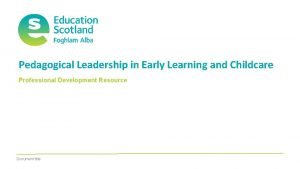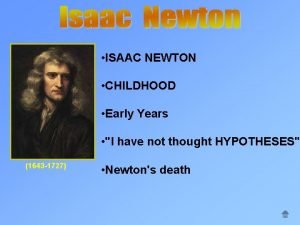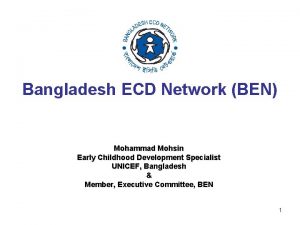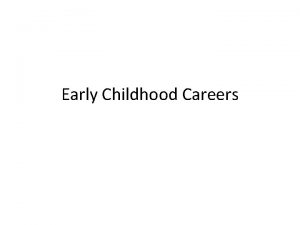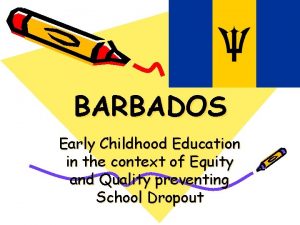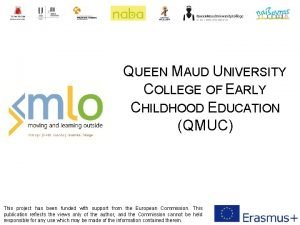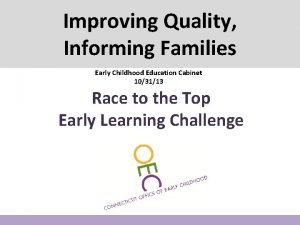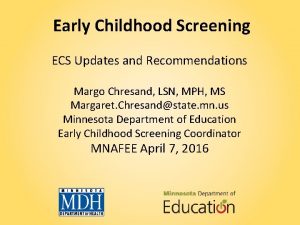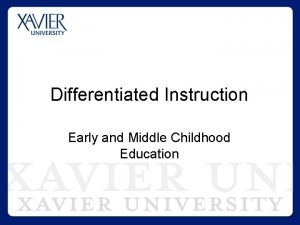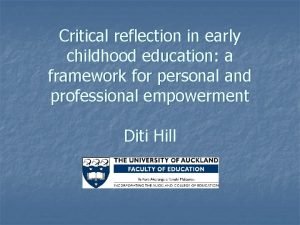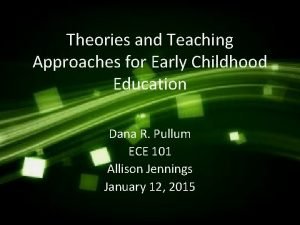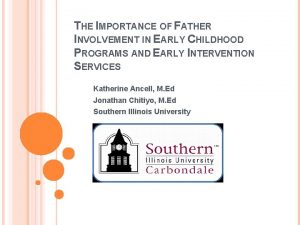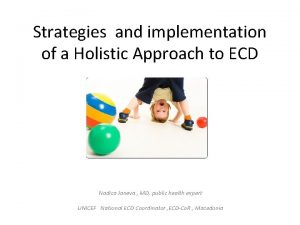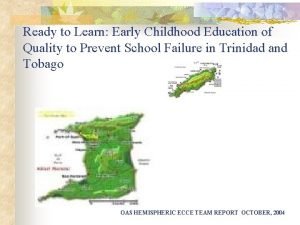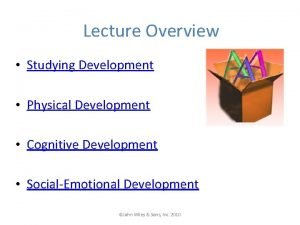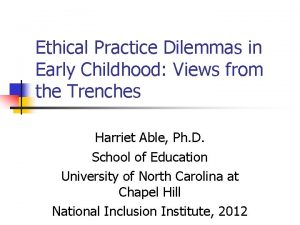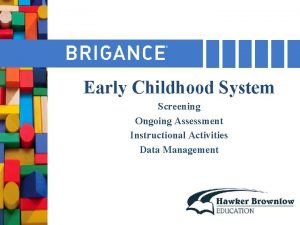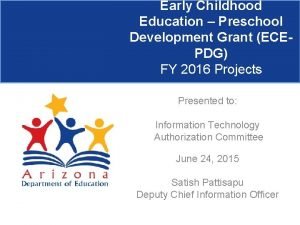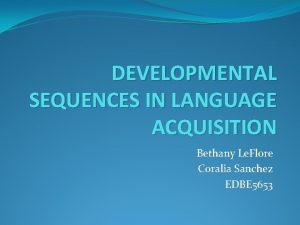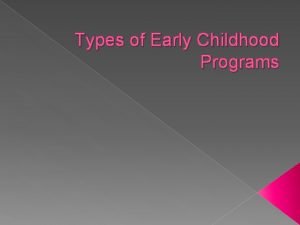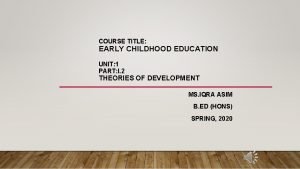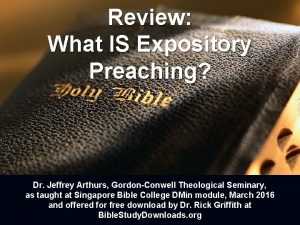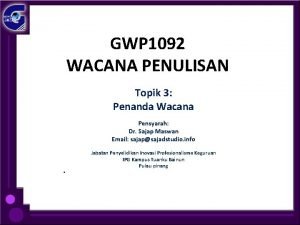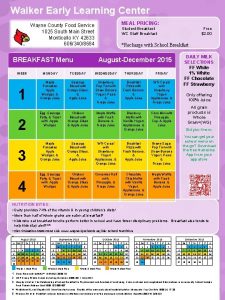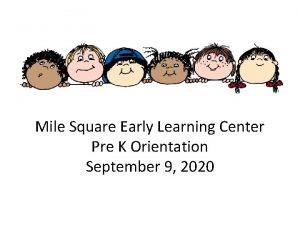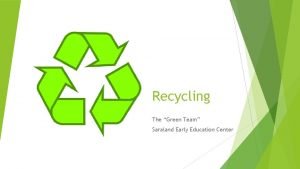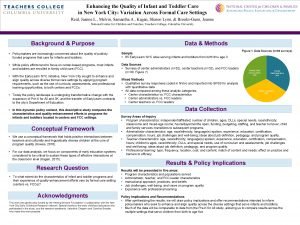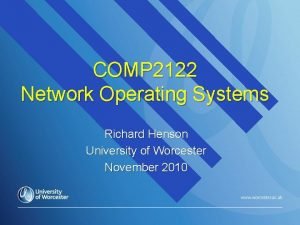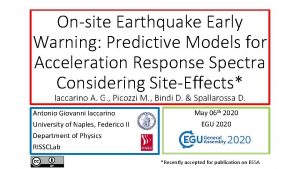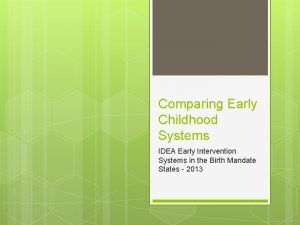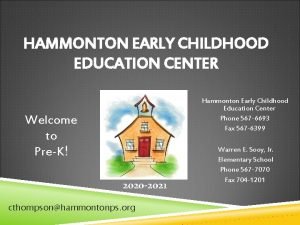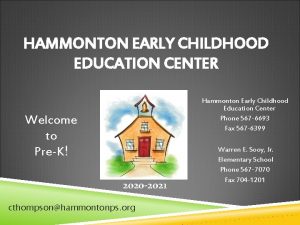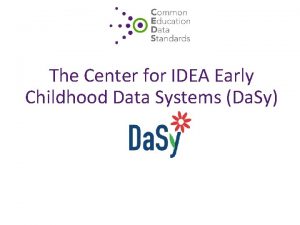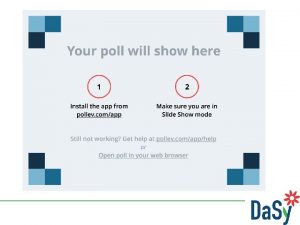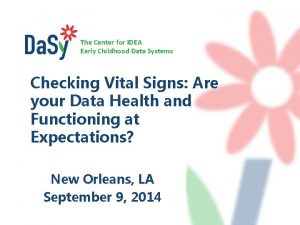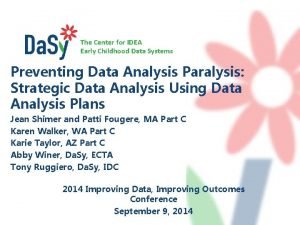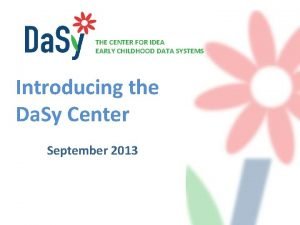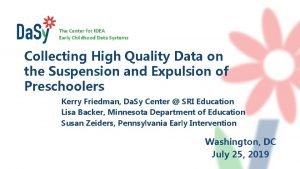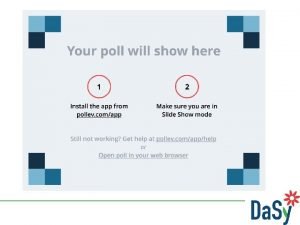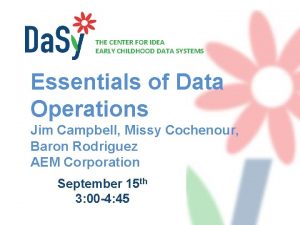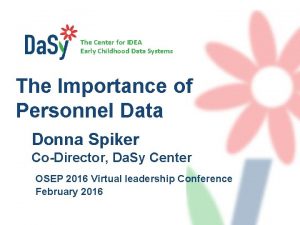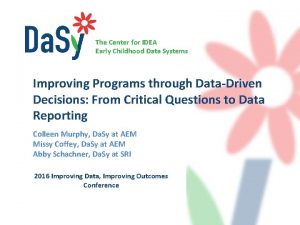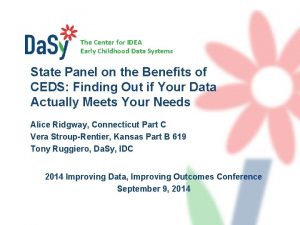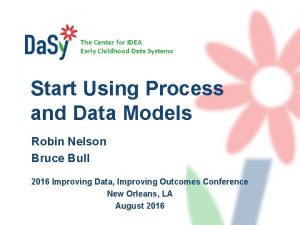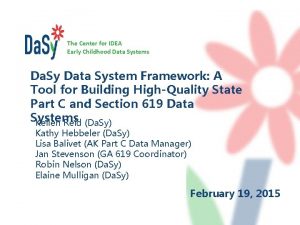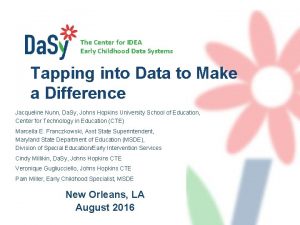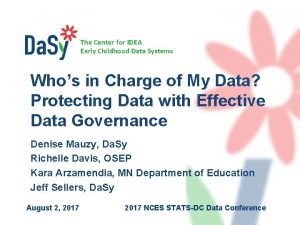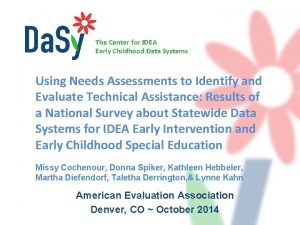THE CENTER FOR IDEA EARLY CHILDHOOD DATA SYSTEMS

















































































- Slides: 81

THE CENTER FOR IDEA EARLY CHILDHOOD DATA SYSTEMS The Early Childhood Workforce Data Landscape Carlise King, ECDC Mary Beth Bruder, ECPC/Da. Sy Denise Mauzy, Da. Sy

Session Goals • Discuss importance of workforce data collection nationally • Review standards and tools that support states’ efforts • Provide information about workforce data collection nationally 2

http: //youtu. be/ur. U-a_Fs. S 5 Y BUILDING ADULT CAPABILITIES TO IMPROVE CHILD OUTCOMES: A THEORY OF CHANGE 3

A Comprehensive Early Childhood Framework Nurturing relationships, safe environments, and enriching experiences that foster learning and development Comprehensive services that promote children’s physical, developmental, and mental health Early Care and Education Family Leadership and Support Health Early Identification, assessment and appropriate services for children with special health care needs, disabilities, or developmental delays 4 Resources, experiences, and relationships that strengthen families, engage them as leaders, and enhance their capacity to support children’s well being Special Needs/ Early Intervention Source: Adapted from Early Childhood Systems Working Group, National Governor’s Association, 2006.

Why Focus on Workforce Data? • How prepared is the early care and education workforce to provide effective education and care for all children? • What policies and investments lead to a skilled and stable early care and education workforce? 5

Who is Our Workforce? Head Start Early Intervention State Preschool Special Education Workforce Categories • • • 6 Assistant teachers Teachers Administrators Family-based professionals Non-teaching professional staff Non-teaching support staff Subsidized Child Care Non-Subsidized Child Care

Presented by: Mary Beth Bruder, Ph. D, Director University of Connecticut A. J. Pappanikou Center for Excellence in Developmental Disabilities Education, Research, and Service 263 Farmington Avenue, MC 6222 Farmington, CT 06030 Phone: (860) 679 -1500 Fax: (860) 679 -1571 E-mail: bruder@nso 1. uchc. edu Website: www. uconnucedd. org

Vision: Effective Early Childhood Models • All Children are Learning • All Personnel Have the Competencies to Insure Learning Occurs in School, Home and Communities

Why an EC CSPD is important States have high quality CSPD (i. e. , multiple state level supports for a competent EC work force) More EC leaders and practitioners working with children and families receiving IDEA services have the requisite knowledge and skills. Note: ECPC will focus on the blue box. The working assumption is that the blue box will produce the green boxes. Large scale change in these areas will occur after the 5 years of the Center. Improved effectiveness of EI, ECSE, and EC services and supports Improved outcomes for children and families 9


Infants and young children with disabilities and their families make the best overall progress when all interventions are consistent across disciplines (special education, related services and early childhood) and settings (early care and education programs, community programs and the home).

Professionals In Early Childhood Intervention Audiologist Physician Nurse Psychologist Nutritionist Social Worker Occupational Therapist Physical Therapist Educator (EC; SPED; ) Speech Language Pathologist

A common core of measurable competency based and authentic personnel preparation standards (standards) is necessary for the preparation of competent personnel who will serve infants, toddlers and preschool children with disabilities and their families using evidenced based recommended practices across settings and environments.

DEC Early Childhood Special Education/Early Intervention Personnel Standards (Birth to Eight) Initial Special Education Professionals • Foundations • Development and Characteristics of Learners • Individual Learning Differences • Instructional Strategies • Learning Environments/Social Interactions • Language • Instructional Planning • Assessment • Professional and Ethical Practice • Collaboration Special Education Early Childhood Specialists • Leadership and Policy • Program Development and Organization • Research and Inquiry • Individual and Program Evaluation • Professional Development and Ethical Practice • Collaboration


LRE Least Restrictive Environment ( 1975): To the maximum extent appropriate, children with disabilities, including children in public or private institutions or other care facilities, are educated with children who are not disabled, and special classes, separate schooling, or other removal of children with disabilities from the regular educational environment occurs only when the nature or severity of the disability of a child is such that education in regular classes with the use of supplementary aids and services cannot be achieved satisfactorily.

Natural Environments (1986) • To the maximum extent appropriate to the needs of the child, early intervention services must be provided in natural environments, including the home and community settings in which children without disabilities participate • Natural environments are settings that are natural or normal for the child’s age peers who have no disability

Personnel Preparation: What we Know and What we Need to Know Mary Beth Bruder, Ph. D. University of Connecticut University Vicki Stayton, Ph. D. Western Kentucky 18

The Center’s Projects • Study I: The National Landscape of Early Intervention and Early Childhood Special Education • Study II: The Higher Education Survey for Early Intervention and Early Childhood Special Education • Study III: The Analysis of Federally Funded Doctoral Programs in Early Childhood Special Education • Study IV: The Impact of Credentials on Early Intervention Personnel Preparation • Study V: Analysis of State Licensure/Certification Requirements for Early Childhood Special Educators 19

The Center’s Projects • Study VI: Training and Technical Assistance Survey of Part C & 619 Coordinators • Study VII: Confidence and Competence of 619/Part C Service Providers • Study VIII: Alignment of ECSE Higher Education Curricula with National Personnel Standards • Study IX: Parent Perceptions of Confidence and Competence of 619/Part C Service Providers • Study X: Case Studies Highlighting States from Study VI on Training and TA 20

Overall Recommendation: Use IDEA to Structure an EC CSPD • Multiple Audiences • Needs Assessment • Preservice • Inservice • Technical Assistance • Personnel Standards • Evaluation 21

A comprehensive system of personal development for the early childhood workforce who serve infants, toddlers and preschool children with disabilities and their families is a necessary and integral quality indicator of an early childhood service system



The Early Childhood Personnel Center (ECPC) will serve as a national resource to State Education Agencies (SEA), Lead Part C agencies, other early care and education agencies, Institutes of Higher Education (IHE), and other entities responsible for professional development of personnel providing early childhood intervention to infants, toddlers, and preschool children with disabilities and their families.

Center Framework Knowledge Generation Technical Assistance and Dissemination Leadership and Collaboration Personnel Policy and Standards Evidenced Based Practice Technology Application Model Development Implementation Science Outcomes and Accountability State Agency and IHE Faculty Certification And Other Personnel Trainers Program Adminand Service Providers Families Graduate Students

HOW? ? • Implementation Science • Regional Collaborations • National Partners • Management and Accountability

Director Mary Beth Bruder (UConn) Co-Director Geroge Sugai (UConn) External Evaluator Evergreen Internal Evaluation Team Mary Louise Hemmeter (Vanderbilt) Jeannette Mc. Collum (U of Illinois) Vicki Stayton (Western Kentucky University) Coordinator Ann Mickelson (UConn) Project Consultants/Contractors Pip Campbell (Jefferson University) Division of Early Childhood Claudia Dozier (KU- ABS/BCBA) Larry Edelman FL State University Regional Associate Directors University of KS Regional Associate Directors Mary Beth Bruder Juliann Woods Mary Frances Hanline Eva Horn David Lindeman Post. Doc Ching-I Chan Gabriela Freyre Calish Post Doc Emily Lakey Cindy Vail Post Doc Stephanie Parks Post Doc Lois Pribble Regional Advisory Board University of CT Regional Associate Director Regional Advisory Board University of of OR OR Regional Associate Director Regional Jane Squires Partner Organizations and Project Advisory Board AUCD CEC ECTA HECSE ITCA NAECS-SDE NAEYC NASDSE NASDTEC CCSSO Part B/619 Consortia NHSA NRCP


Regional Center Region States University of Connecticut 1 Connecticut, Maine, Massachusetts, New Hampshire, Rhode Island, Vermont University of Connecticut 2 New Jersey, New York, Puerto Rico, Virgin Islands University of Connecticut 3 Delaware, Washington DC, Maryland, Pennsylvania, Virginia, West Virginia Florida State University 4 Alabama, Florida, Georgia, Kentucky, Mississippi, North Carolina, South Carolina, Tennessee Florida State University 5 Illinois, Indiana, Michigan, Minnesota, Ohio, Wisconsin, (Iowa) University of Kansas 6 Arkansas, Louisiana, New Mexico, Oklahoma, Texas University of Kansas 7 Iowa, Kansas, Missouri, Nebraska, (Iowa to FSU) University of Kansas 8 Colorado, Montana, North Dakota, South Dakota, Utah, Wyoming University of Oregon University of Hawaii 9 Arizona, California, Nevada Hawaii, Guam, American Samoa, Marianna, Marshal Palou, Micronesia University of Oregon 10 Alaska, Idaho, Oregon, Washington

ADMINISTRATION AND MANAGEMENT Data Collection and Analyses of Personnel Policies; Literature Reviews, Syntheses and Papers Review of DEC Personnel Practices, Standards; Refine Standards across Disciplines General TA through Meetings, Webinars, Product Development and Dissemination Targeted TA and Dissemination to Specific Populations on Personnel Procedures, Policies and Practices Intensive TA to 8 States to Develop, Implement and Sustain a Model CSPD in EC for Infants and Young Children with Disabilities EVALUATION AND CONTINUOUS IMPROVEMENT Leadership through Collaborations; Training Institute for C/619 Coordinators; Training on Scaling up CSPD’s

NASDSE

State Personnel Standard: Credential/Licensure/Certification Data STATE __(A)_____ DISCIPLINE (B) A. Name of Credential/ Licensure/Certification/Endorsement for discipline (e. g. , to allow candidate to work with 0 -5 year olds with disabilities in this discipline) by number and description (e. g. Pre. K – 3 rd grade; birth though grade 12) (C) 1. Which State Department Issues and oversees it (D) 2. Type (E) 3. Age (F)

4. Standard Requirements a. Educational Requirements i. Degree A. Level ( Associates, Bachelors, Masters, Doctoral) (G) B. List of approved programs in IHE or link to list (H) ii. Curricular/Coursework requirements( y/n) (I) Details (J) iii. Clinical/Practicum Requirements (y/n ) (K) Details (L) iv. Post-graduation Requirements (y/n) (M) details (N) b. Exam Requirements (national ( EG Praxis) and/or state (y/n) (O) i. Specifics (P)

c. Additional/Different requirements to work with infants and toddlers( y/n) (Q) i. Details (R) d. Additional /Different requirements to work within public school settings (y/n) (S) i. Details (T) e. Additional/Different requirements to work with special populations (y/n) (U) i. Details (V) 5. Alternative Route Requirements( y/n) (V) a. Experience/ coursework/exam (W) 6. Provisional and/or temporary Credential /Licensure/Certification (y/n) (X) b. Experience/coursework/exam (Y) 7. Reciprocity with other states(y/n) (Z) a. Details (AA)

Category (by order in the data table) Definition Discipline* The licensure/certification/endorsement category which may include several types and paths in separate entries. State Department Granting Licensure/Certification The state department that is responsible to setting requirements and granting the license/certificate( usually education or health). Name of License/Certificate The EXACT title or name associated with the licensure /certification on the state webpages. Type of Licensure/Certification** The licensure/certification /endorsement Age Range The age population the license/certificate/endorsement holder will be able to work with. Minimum Education Level Minimum degree level required to receive a license/certificate.

Category (by order in the data table) Definition The EXTRA requirements and parameters (e. g. , specific coursework, training, and experiences) for Additional Requirements for Working the license/certificate holder to work with infants in Early Intervention (Birth to Three) and toddlers with special needs (under Part C of the Individuals with Disabilities Education Act)This is not standard requirement The EXTRA requirements and parameters (e. g. , specific coursework, training, and experiences) for Additional Requirements for Working the license/certificate holder to work with in Preschools/School Districts (Three preschoolers with special needs (under Part B 619 to Five) of the Individuals with Disabilities Education Act)This is not a standard requirement The National Organization(s) Referenced If Yes Name of the national organization that its licensure/certification requirements/standards were referenced by the state as basis for statelevel requirements/standards.

Category (by order in the data table) State-Level Requirements/Standards Specific Curriculum/Coursework Requirements Specific Field or Clinical Work Requirements Licensure/Certification Exam Definition If yes Relates to standards used to base licensure on that are UNIQUE to and are DEVELOPED BY THE STATE – requirements that are above and beyond national standards or in place of national standards. Specific curriculum/training topics, coursework or number of credits required in preparation programs leading to licensure eligibility. Specific number of field/clinical hours or other parameters (i. e. , work with specific population) required by the state in preparation programs. The national-level or state-level exam required to pass to obtain the license/certificate. National-level or State-level competencies (e. g. , knowledge and skills demonstrated by the Competency Referenced by the Licensure/Certification Requirements licensee) that the state licensure/certificate requirements are based on.

Category (by order in the data table) Definition For field or clinical work requirements that are part of the TYPICAL licensure/certification Specific Post-Academic Field or preparation path. The temporary permit or Clinical Work Requirements (Including provisional license granted to allow interns to Provisional/Temporary License Issued practice while waiting for exam results or fulfilling to Interns) post-graduate clinical fellowships is under this category. Other paths that lead to the license/certificate Alternative Routes for rather than completing the traditional Licensure/Certification (Including preparation program. The temporary/emergency Emergency/Temporary License Issued license issued due to shortage areas or special to Professionals) circumstances is under this category. # of IHEs Offering Programs Leading to Licensure/Certification The number of higher education programs preparing folks for the license/certificate through TRADITIONAL and ALTERNATIVE paths.

Category (by order in the data table) Requirements for Licensure/Certification Reciprocity with Other States Definition 1. The requirements for an individual who is previously licensed in another state but wants to become licensed in the state of interest. 2. Initial licensure that allows candidates to qualify for licensure in states other than where they complete their preparation through interstate agreements. State-Level Licensure Web Links State-level web links that provide critical information about the license/certificate Additional Information Other important information that does not fit in the above categories.

*Discipline for data collection: Early Childhood Special Education (ECSE) Early Childhood Education (ECE) – does not include Head Start and Child Care information. Occupational Therapist (OT) Physical Therapist (PT) Speech Language Pathologist (SLP) Audiologist Registered Nurse

** Type of licensure/certification applied: 1. Licensure/Certification 2. Licensure/Certification (SPECIFIC) with Endorsement 3. Endorsement (Added to various licenses) 4. Unified/Blended License/certificate [e. g. , EC/ECSE] 5. Dual Certification (IF TWO DISTINCT Certifications are REQUIRED AT STATE LEVEL) 6. Other (e. g. , advanced training not leading to licensure or endorsement) 7. Social Worker 8. Family Therapist 9. Clinical Psychologist 10. School Psychologist 11. Vision Specialist – focus on teaching license/certificate 12. Deaf and Hard of Hearing Specialist – focus on teaching license/certificate

Two Sample States • Disciplines(n=11): • • • Psychologist Vision Specialists ECE (Regular Educator) ECSE (Special Educator) Social Worker Occupational Therapist Physical Therapist Speech Language Pathologist Audiologist Family Therapist Registered Nurse



Age Range and Degree Level Requirements Age range: • 4 distinct age ranges • • 3 yrs to 12 th grade (n=3) 3 yrs to 2 nd grade (n=1) Birth to death (n=6) • 3 distinct age ranges • 3 yrs to 12 th grade (n=2) • 3 yrs to 5 yrs (n=1) • Birth to death (n=8) Minimum degree : • Bachelor Degree (n=4) • Masters Degree (n=4) • Doctoral Degree (n=3) • • • Bachelors Degree (n=3) Masters Degree (n=4) Doctoral Degree (n=2) Associate Degree (n=1) Unclear (n=1)

Taking a look at two specific disciplines… • Selected two disciplines: • ECSE – considered to be most complex • OT = considered to one of the least complex

ECSE & OT across 30 states…Age Ranges • ECSE = 15 age ranges • • • • 3 yrs to 12 th grade (n=4) 3 yrs to 5 yrs (n=1) 3 yrs to 3 rd grade (n=3) 3 yrs to 2 nd grade, (n=1) Birth to K (n=3) Birth to 3 years (n=9) Birth to 2 nd grade (n=2) Birth to 3 rd grade (n=5) Birth to 4 th grade(n=1) Birth to 5 yrs (n=5) Birth to 6 yrs (n=1) Birth to 7 yrs (n=1) Birth to 8 yrs (n=2) K-12 th grade (n=1) Birth to 12 th grade (n=3) • OT= One age range • Birth to death

ECSE & OT across 30 states… Type of Licensure: ECSE - FIVE types OT – TWO types • Licensure/Certification (n=13) • Licensure/Certification(n=28) • Licensure/Certification plus endorsement (n=18) • Licensure/Certification plus endorsement (n=3) • Endorsement (n=4) • Dual certification required (n=1) • Blended or Unified Licensure (n=4) • Non-Licensure (n=1) • Unclear (n=2)

ECSE & OT across 30 states… Alternative route to licensure? ECSE: • Alternative route exists in 97% (n= 45) OT: • Alternative route exists in 1% of states (n=31)

ECSE & OT across 30 states… Minimum degree level required: ECSE = OT = • Masters (n=2) • Bachelors (n=39) • High School Diploma (n=1) • Did not specify (n=1) • Unknown (n=1) • Masters (n=24) • Bachelors (n=6) • Completion of nationally accredited program (n=1)

ECSE & OT across 30 states… Licensure dependent on exam? • ECSE • 84% (n=44) • OT • 100% (n= 31) Reciprocity with other states? • ECSE • 68% (n=44) • OT • 84% (n=31)

National Assessment of CSPD Components • Ongoing needs assessment • Appropriate licensing and certification • IHE programs to provide pre-service training • Ongoing, systematic and effective in-service opportunities • A data system for personnel • Evaluation • TA availability • Dissemination

States Reporting CSPD Components ( Data Collection is Not Completed) Ongoing Needs Assessment Part B/619 Grand Total (count/ percent) (N=24) Part C Grand Total (count/ percent) (N=28) 10 (41. 7%) Appropriate Licensing and Certification 19 IHE Ongoing, programs Systematic to provide and Effective pre-service PD in-service training opportunities 21 17 11 12 (70. 8%) (45. 8%) (50%) 8 12 (79. 2%) (87. 5%) 15 21 18 (53. 6%) (75%) (64. 3%) A Data Evaluation System for Personnel TA Availability Dissemination 18 (75%) 16 (66. 7%) 20 (28. 6%) (42. 9%) (71. 4%) 19 (67. 9%)

Next Steps: Da. Sy

Workforce Data Systems: Data Elements for Part C Demographics 29% 40% Employment information 54% Education Licenses/ certifications 23% 56% Professional development 14% 39% Wages 31% 10% 0% 29% 12% 46% 54% 10% 20% 30% 40% 2% 29% 6% 29% 2% 29% 50% 60% 70% 8% 90% 100%

Workforce Data Systems: Data Elements for Part B 619 Special Education Preschool Teachers Demographics 67% Employment information 15% 77% Education 12% 75% Licenses/ certifications 8% 83% Professional development 29% Wages 52% 46% 0% 10% 20% 35% 30% 40% 50% 60% 70% 80% 14% 4% 14% 6% 90% 100%

Related Services Personnel Demographics 58% Employment information 14% 60% 12% 58% Education Licenses/ certifications 14% 69% Professional development 2% 29% Wages 42% 0% 10% 27% 30% 40% 50% 60% 25% 4% 25% 4% 25% 70% 80% 6% 90% 100%

General Education Teachers Demographics 64% Employment information 8% 67% 4% 64% Education Licenses/ certifications 6% 71% Professional development 23% Wages 10% 46% 20% 23% 30% 4% 25% 6% 4% 25% 46% 0% 25% 50% 60% 70% 25% 6% 80% 90% 100%

Linkages Part C Child 56% 8% Program 10% 12% Workforce 10% 20% 6% 8% 65% 33% 0% 31% 12% 30% 40% 6% 21% 50% 6% 29% 60% 70% 80% 90% 100%

Linkages Part B 27% 35% 10% 17% 12% 56% 33% 0% 10% 25% 30% 4% 35% 40% 50% 6% 29% 60% 70% 10% 80% 90% 4% 100%

Unique Identifiers Across C/619 • Only 17% of Part C coordinators reported that there are common unique child identifiers used by both Part C and Part B 619 data systems, while 31% of Part B 619 coordinators reported having common unique child identifiers across the two data systems (Figure 10). • Few Part C and Part B 619 coordinators reported the use of common school or program unique identifiers across the two programs’ data systems (8% and 17% of states, respectively).

Next Steps: ECPC


Web Site Information Center Information http: //www. ecpcta. org/ Data Reports http: //www. uconnucedd. org/projects/early_childhood/publications. ht ml 65

EARLY CHILDHOOD AND SCHOOL AGE REGISTRIES: A STATE WORKFORCE DATA COLLECTION TOOL 66

What is a registry? • comprehensive workforce information system • collects essential data on early childhood and school age professionals • recognizes professional attainment and supports PD planning • an integral part of the infrastructure for state professional development systems • serves as a hub for data collection, reporting, and analyses 67

68

Primary/Typical Registry Recruitment Practitioners/Teachers Others Child Care Centers • Trainers Family Child Care • Technical Assistance Providers Head Start Public Pre K Faith-based Child Care Any program participating in a QRIS • Any professional participating in state PD activities tracked by registry • Others • • • 69

Core Registry Data Collection Functions • User information • Workforce ID • • Demographic Employment Verified education data Verified training data 70

Registry as a “Hub” 71

HOW MUCH OVERLAP EXISTS BETWEEN REGISTRY AND IDEA DATA COLLECTION? 72

Alaska • The Alaska SEED Registry has an Early Intervention (EI) and Infant Learning Program (ILP) track on the SEED Career Ladder. • All EI/ILP professionals are required by their program to be in the Alaska SEED Registry. • Comprehensive data on Part C • No recruitment or data relationships with Part B/619 or teacher licensure 73

Illinois • Early intervention has been invited to participate in recruitment planning activities • No current targeted recruitment for early intervention or pre-school special education • Staff members who work in licensed programs are required to be in the registry • Preschool for All staff (certified and non-certified) required to join registry • Working on project involving data exchange of certified teacher data 74

Ohio • Early Intervention Service Coordinators and Supervisors are required to participate in the registry • Registry administers credentialing process • Provide information to Department of Health monthly • Teacher licensure has its own system • All Department of Education programs will be mandated to participate due to TQRIS and the ELCG • Working one-time data dump for licensure information for all teachers employed in programs participating in QRIS 75

2012 Workforce Dataset: A Review of Workforce Trends REGISTRY DATA: MONITORING WORKFORCE TRENDS 76

Partnership Eligibility Review • Completion of Verification Process • Alignment with Core Data Elements for Early Childhood and School-Age Registries • Policies and Procedures Related to Data Collection Processes • 9 Registries Approved • 8 state, 1 regional • Participate in National Registry Alliance Workforce Dataset and other partnerships 77

78

79

80

QUESTIONS AND DISCUSSION 81
 Proximodistal development
Proximodistal development Bellfort early childhood center
Bellfort early childhood center Becc brownsburg
Becc brownsburg Flushing latchkey
Flushing latchkey Early childhood outcomes center
Early childhood outcomes center Schoenbaum family center
Schoenbaum family center Types of early childhood programs
Types of early childhood programs Types of early childhood programs chapter 2
Types of early childhood programs chapter 2 Efq framework
Efq framework Early childhood framework for quality
Early childhood framework for quality Ecetp trainings
Ecetp trainings How to welcome parents in orientation
How to welcome parents in orientation Early childhood directorate nsw
Early childhood directorate nsw Leonardo da vinci's childhood
Leonardo da vinci's childhood Fine motor skills development in early childhood
Fine motor skills development in early childhood Trends in early childhood education
Trends in early childhood education Physical development in early childhood
Physical development in early childhood Early childhood research quarterly
Early childhood research quarterly Garda vetting form early childhood ireland
Garda vetting form early childhood ireland Psychosocial development in early childhood
Psychosocial development in early childhood Chapter 7 early childhood ages 3 through 5
Chapter 7 early childhood ages 3 through 5 Schirrmacher stages of artistic development
Schirrmacher stages of artistic development Facts about amelia earhart's childhood
Facts about amelia earhart's childhood Language development in early childhood
Language development in early childhood Pakistan alliance for early childhood
Pakistan alliance for early childhood Pedagogical leadership definition
Pedagogical leadership definition Newton childhood
Newton childhood Eminem early childhood
Eminem early childhood Ece in pakistan
Ece in pakistan A vygotskian classroom promotes ________.
A vygotskian classroom promotes ________. Early childhood education in bangladesh
Early childhood education in bangladesh Associates in early childhood education jobs
Associates in early childhood education jobs What is biosocial development in early childhood
What is biosocial development in early childhood Early childhood education barbados
Early childhood education barbados Queen's university early childhood education
Queen's university early childhood education Kentucky governor's office of early childhood
Kentucky governor's office of early childhood Connecticut early childhood education cabinet
Connecticut early childhood education cabinet Early childhood screening rochester mn
Early childhood screening rochester mn Early childhood development with differentiated instruction
Early childhood development with differentiated instruction Smyth reflection example
Smyth reflection example He instilled into the mind of jose the love for education.
He instilled into the mind of jose the love for education. Skinner's operant learning theory
Skinner's operant learning theory Father involvement in early childhood
Father involvement in early childhood Holistic approach in early childhood education
Holistic approach in early childhood education Swot analysis early childhood education
Swot analysis early childhood education Development
Development Cosf examples
Cosf examples Ethical dilemmas in early childhood education
Ethical dilemmas in early childhood education Ongoing assessment early childhood
Ongoing assessment early childhood Early childhood education
Early childhood education Developmental sequence in language acquisition
Developmental sequence in language acquisition Three types of early childhood programs
Three types of early childhood programs Emily dickinson adulthood
Emily dickinson adulthood Bf skinner early childhood education
Bf skinner early childhood education Early cpr and early defibrillation can: *
Early cpr and early defibrillation can: * Is the theme the main idea
Is the theme the main idea Homiletical idea
Homiletical idea Controlling idea adalah
Controlling idea adalah What is the difference between topic and theme
What is the difference between topic and theme Example of irrelevant sentences
Example of irrelevant sentences Tell more about the main idea
Tell more about the main idea 5 penanda wacana
5 penanda wacana Walker early learning center
Walker early learning center Square one early learning center
Square one early learning center Saraland early education
Saraland early education Adelphi early learning center
Adelphi early learning center Example of an operating system?
Example of an operating system? Early operating systems
Early operating systems Earthquake early warning systems
Earthquake early warning systems Earthquake early warning systems
Earthquake early warning systems Formuö
Formuö Typiska novell drag
Typiska novell drag Nationell inriktning för artificiell intelligens
Nationell inriktning för artificiell intelligens Vad står k.r.å.k.a.n för
Vad står k.r.å.k.a.n för Varför kallas perioden 1918-1939 för mellankrigstiden?
Varför kallas perioden 1918-1939 för mellankrigstiden? En lathund för arbete med kontinuitetshantering
En lathund för arbete med kontinuitetshantering Särskild löneskatt för pensionskostnader
Särskild löneskatt för pensionskostnader Personlig tidbok för yrkesförare
Personlig tidbok för yrkesförare A gastrica
A gastrica Densitet vatten
Densitet vatten Datorkunskap för nybörjare
Datorkunskap för nybörjare Tack för att ni lyssnade bild
Tack för att ni lyssnade bild

